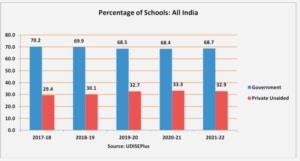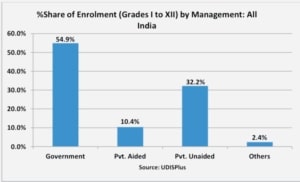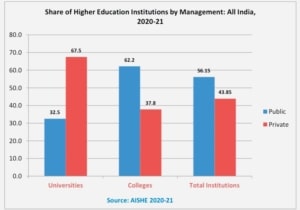Privatization of Education in India by Prof. Arun C Mehta
Public vs. Private: Understanding the Shifting Landscape of Indian Education (2024)
Introduction
Over the past two decades, India has witnessed a rapid increase in privatization within its education sector. The presence of private schools and colleges has multiplied across the Country. In 2021-22, private unaided schools accounted for over 32 percent of total schools imparting education in India. In higher education, 67.51 percent of 1,385 universities and 37.81 percent of 60,127 colleges in India are private.
This trend towards privatization has been accompanied by commercialization, with education being seen as a lucrative business opportunity by investors and entrepreneurs. While privatization has expanded access to education, it has also raised concerns about commercialization, inequity, quality, and regulation.
The present article analyses the key trends, debates, and implications surrounding the privatization of education in India exclusively based on government-owned data (UDISEPlus and AISHE) available in the public domain.
The Rise of Private Schools in India
The total number of schools covered under the UDISEPlus during the years 2017-18 to 2021-22, along with the schools run by the Department of Education/Government as well as under the Private Undaided Schools presented in Table 1, shows a consistent increase in the share of the private unaided schools contrary to which the share of schools run by the Government/Department of Education shown a decline all through the period 2017-18 to 2021-22.
Incidentally, from the year 2018-19, UDISE has been managed by the Department of School Education and Literacy of the Ministry of Education, before which the same was handled by the premier national institute, namely NIEPA, ever since the inception of DISE in 1994-95 to 2017-18. Not only has the number of schools covered under the UDISEPlus declined recently, but the time lag, which was brought down to less than a year at one point in time, has again started to increase, which is about three years at the national level. 2021-22 is the latest year, recorded on 30 September 2021, for which UDISEPlus data is available.
Table 1: Total Number of Schools Covered under UDISEPlus: 2017-18 to 2021-22
|
Year |
Number of Schools | %age to Total Schools | |||
| Total | Government/DoE | Private Unaided | Government/DoE | Private Unaided | |
| 2017-18 | 1558903 | 1094543 | 322201 | 70.21 | 29.44 |
| 2018-19 | 1551000 | 1083747 | 326228 | 69.87 | 30.10 |
| 2019-20 | 1507708 | 1032570 | 337499 | 68.49 | 32.69 |
| 2020-21 | 1509136 | 1032149 | 343314 | 68.39 | 33.26 |
| 2021-22 | 1489115 | 1022386 | 335844 | 68.66 | 32.85 |
Source: UDISE/UDISEPlus, various years.
Table 1 reveals that the share of Private Unaided schools in India has consistently increased from a low of 29.44 percent in 2017-18 to 30.10 percent in the following year and further to 32.69 percent in 2019-20, to 33.26 percent in 2020-21 but slightly declined to 32.85 percent in the next year, i.e., 2021-22. Consequently, the share of schools run by the Government/Department of Education declined from 70.21 percent in 2017-18 to 68.66 percent in 2021-22. In other words, one may say that private unaided managements manage more than 3 out of every ten schools in India, which indicates that India is slowly but surely moving towards having more private schools.
Total Number of Schools in India: 2017-18 to 2021-22
It is recalled that the number of schools covered under UDISE+ 2019-20 declined by 43,292 schools (-2.8 percent), and the same in the case of schools under the Department of Education management declined by 51,177 thousand schools (4.72 percent), but details are not presented in UDISE+ Report/Booklet on reasons behind the drastic decline in coverage of schools under UDISE+ 2019-20. In the latest year, i.e., 2021-22, the total number of schools covered under UDISE+ is lesser by 20,021 schools (1.33 percent), and that of schools managed by the Government, 9,663 schools (0.94 percent).
Private schools have proliferated even in small towns and villages, catering to middle and low-income families seeking English-medium education. Private unaided schools have increased by 4.23 percent from 2017-18 to 2021-22, while government schools have declined by -6.59 percent during the same period.
Whether all these government schools closed down or declined because of the merger is a moot question that has not been provided in the official document. Like UDISE+ 2020-21, UDISE+ 2021-22 Booklet is silent on the number of schools covered and starts its analysis directly on enrolment. However, under the paragraph on the Impact of the COVID-19 Pandemic on Enrollment, it has been casually mentioned that “The decline in total schools is mainly due to closure of schools under private and other management.” However, it has failed to note that the number of schools managed by the Government has also declined by 9,663, which is a little less than a percent of the total number of government schools (0.94 percent) during the previous year.
Further, it is observed that at the time of taking over the responsibility of UDISE from NIEPA, as many as 15,58,903 schools were covered under UDISE in 2017-18, which has come down to 14,89,115 schools; thus indicating that UDISE+ 2021-22 covered a lesser number of schools compared to the same in 2017-18 and the difference is to the tune of hoping 69,788 schools (-4.48 percent); this indicates that about 5 out of every 100 schools covered in 2017-18 were not covered in 2021-22. It is hoped that the Ministry will furnish reasons for the steep decline in schools, the criteria used, and whether the RTE norms of distance were followed.
Table 2: Number of Schools (All Schools): All-India
| Year
|
Total Number
of Schools |
Increase/
Decrease
|
%age
Change
|
Total Government/
DoE Schools
|
Increase/ Decrease
|
Total Private Schools
|
Increase/ Decrease
|
| 2017-18 | 15,58,903 | 1094543 | 322201 | ||||
| 2018-19 | 15,51,000 | -7,903 | -0.5 | 1083747 | -10796 | 326228 | 4027 |
| 2019-20 | 15,07,708 | -43,292 | -2.8 | 1032570 | -51177 | 337499 | 11271 |
| 2020-21 | 15,09,136 | 1,428 | 0.09 | 1032149 | -521 | 343314* | 5815 |
| 2021-22 | 14,89,115 | -20,021 | -1.33 | 1022386 | -9663 | 335844 | -7470 |
| 2017-18
to 2021-22 |
-69,788 | -4.48% | -72,157 | -6.59 %
|
13,643 | 4.23%
|
Source: UDISE & UDISE+, different years. *Number of published schools were 3,40,753 schools in 2020-2.
Enrolment Trends in School Education in India: 2017-18 to 2021-22
Like the number of schools, a similar pattern is observed in the school enrolment by management, presented in Table 3, which is reported to be 32.24 percent in 2021-22 compared to a high of 35.43 percent in 2018-19. However, in 2019-20, the same was the highest, i.e., 35.43 percent throughout 2017-18 to 2021-22. The private aided and unaided schools had an enrolment share of 42.66 percent in 2021-22, meaning that about 43 out of every 100 students in Grades I to XII in 2021-22 were enrolled in schools under private management.
Factors Driving the Growth of Private Schools in India
The expansion of private schools in India is attributed to several compelling reasons:
-
Aspiration for English-Medium Education and Perception of Quality:
There is a prevalent perception, often fueled by annual surveys, that private schools offer a higher quality of education, particularly in English-medium instruction. This perception has led to a preference for private schools over government-managed ones. However, it is essential to note that not all government schools exhibit low quality, nor are all private schools uniformly superior.
Table 3: Share of Enrolment by Management: All India, 2017-18 to 2021-22
| School Management & Year | Share of Enrolment (Grades I to XII) by Management | ||||
| 2017-18 | 2019-20 | 2020-21 | 2021-22 | ||
| Government | 52.50 | 51.06 | 52.18 | 54.94 | |
| Private Aided
Management |
11.15 | 10.76 | 10.42 | 10.42 | |
| Private
Unaided |
33.19 | 35.43 | 34.71 | 32.24 | |
| Others | 3.15 | 2.75 | 2.70 | 2.40 | |
| Total Enrolment: Grades I to XII | 250989193 | 250971683 | 253804461 | 255740623 | |
Source: UDISE & UDISE+, different years.
-
Shortcomings in Public Education
: Public education in India faces challenges such as teacher absenteeism and inadequate infrastructure. These issues have prompted many parents, even those from low-income families or areas lacking public schools, to opt for private education due to doubts about the quality of education in government schools. Some parents are willing to allocate a significant portion of their income to enroll their children in private schools, expecting a better education.
-
Population Growth and Increased Demand for Education:
The rapid growth of private schools can also be attributed to the expanding population and heightened demand for education. However, specific enrollment data for the school-age population in 2024 is not available due to the absence of the 2021 Census. Nevertheless, indicators such as gross and net enrollment ratios, dropout rates, and transition rates, which are crucial for district-level planning under initiatives like Samagra Shiksha, are often challenging to obtain, making it difficult to accurately gauge demand at the local level.
-
Policy Support:
The implementation of the Right to Education Act in 2009 recognized and initially spurred the growth of private education providers. The Act also allowed private, unaided, unrecognized schools to seek recognition. However, the subsequent dynamics in the private and public school sectors, including mergers, de-mergers, and closures, are not extensively documented in the public domain. Additionally, compliance with distance norms per the Right to Education Act remains pertinent but often overlooked.
-
Investment Opportunities and Lucrative Business Prospects:
The education sector, including school and higher education, has increasingly become an attractive avenue for investment, not limited to specific regions but permeating the Country, contributing to the rapid growth of private education institutions.
These factors collectively contribute to the notable expansion of private schools in India and underscore the complex landscape of educational choices and provision in the Country.
Private Higher Education Institutions
It is not that the number of private schools has increased in India in the recent past, but the majority of institutions imparting higher education are also private institutions.
Table 4: Higher Education Institutions & Enrolment under Public (Government) and Private Managements in India: 2020-21
| Management Type | Universities | Colleges | Total Institutions | Enrolment (Millions) | Percentage Share |
| Public | 450 (32.49%) | 37392 (62.19%) | 41842 (56.15%) | 25.2 | 51.3 |
| Private | 935 (67.51%) | 22735 (37.81%) | 32670 (43.85%) | 23.8 | 48.7 |
| Total | 1385 | 60127 | 74512 | 49.0 | 100.0 |
Source: AISHE 2020-21
Here is the analysis of the data on higher education institutions and enrollment in India based on AISHE 2020-21:
- There were 74,512 higher education institutions in India, of which 1385 were universities and 60,127 were colleges.
- 15 percent of the institutions were public (Government), while 43.85 percent were private.
- In absolute numbers, there were only fewer public (Government) universities (450) than private ones (935). However, there were significantly less number of private colleges (22,735, 37.81 percent) than public colleges (37,392, 62.19 percent).
- Total student enrollment in higher education was 49 million, of which 51.3 percent were in public institutions and 48.7 percent in private institutions.
- Regarding total enrollment, public institutions had a slight edge over private ones – 25.2 million students in public institutions compared to 23.8 million in private institutions; this is likely because government universities are more affordable than private universities.
- However, regarding the percentage share of enrollment, public and private institutions had almost equal shares – 51.3 percent in public and 48.7 percent in private.
In summary, while public institutions dominate the total number of universities and colleges, private institutions have quickly caught up in enrollment shares. The private sector has mainly seen growth in the number of colleges. Overall, the higher education system appears to be evenly split between public and private participation in terms of enrollment. The privatization of higher education in India is a controversial issue. Some people believe it is necessary to improve the quality of education, while others think it will lead to increased inequality, but the data from AISHE 2020-21 does not answer such questions. However, it shows that private institutions are increasingly important in higher education in India.
Commercialization of Education
Privatizing education has resulted in accusations of becoming a money-spinning business. Private coaching centers and tutoring classes have become a billion-dollar industry. Education technology and English training are estimated to be among the fastest-growing markets globally, presenting enormous opportunities for entrepreneurs and investors. The profit motive and lack of regulation around fees have resulted in allegations of profiteering and commercialization. The Supreme Court has noted that educational institutions cannot charge capitation fees or make education a business. However, regulating commercialization while encouraging private investment remains a challenge.
Public Investment in Education
Public investment in education also needs to be enhanced to ensure inclusive quality education for all. India currently invests around 4.3 percent of its GDP in education, lower than the 6 percent recommended by the Kothari Commission. The National Education Policy 2020 has once again set the goal of increasing public investment in education to 6 percent of GDP; this will involve doubling the education budget to Rs 2.94 lakh crore. Enhanced investment is imperative to universalize quality education, as the Right to Education Act mandates. Partnerships between government and private sector institutions can potentially optimize outcomes. However, the commercialization of education needs checks and balances to live up to the principles enshrined in the Right to Education Act.
Debating Privatization: Pros and Cons
There is intense debate about whether the privatization and commercialization of education are beneficial for India or not. A few pros and cons are listed below. In addition, there are a few Regulatory Issues, a few of which are listed below.
Potential Benefits
- Expanded access to education – Private providers have increased seats and enabled access
- More choices for parents and students
- Competition can drive improvements in public schools
- Increased investment in education
- Promoted innovation through the use of technology
Concerns Raised
- Inequity – Poorer students get excluded due to high fees
- Commercialization and lack of regulation result in profiteering
- Quality concerns – mismatch between skills and employability
- Segregation on income lines with parallel education systems
- Teacher exploitation – low pay, lack of job security
Regulatory Issues
The regulatory oversight of private schools and institutions has been weak. Key issues include:
- No control over fees charged, resulting in unaffordability
- Lax approval processes allow substandard colleges to proliferate
- Poor implementation of RTE quotas for disadvantaged students
- Bypassing teacher eligibility criteria
- Lack of focus on learning outcomes
Strengthening regulation without stifling innovation is a significant challenge. Regulatory reforms in fee structures, teacher qualifications, and learning outcomes are required.
Implications and Way Forward
Privatizing education has had far-reaching implications on equity, quality, and access. As private actors continue to dominate, strengthening regulation and oversight is imperative. A balance needs to be maintained between expanding access and addressing commercialization.
Public investment in education also needs to be enhanced to ensure inclusive quality education for all. Partnerships between government and private sector institutions can potentially optimize outcomes. However, the commercialization of education needs checks and balances to live up to the principles enshrined in the Right to Education Act.
Concluding Observations
In conclusion, the privatization of education in India has witnessed fast growth in the last two decades, with private schools and colleges playing an increasingly dominant role in the education landscape. While this shift has expanded access to education and provided more choices for students and parents, it has also raised concerns about commercialization, inequity, and quality of education.
The UDISEPlus data presented in the analysis indicates a consistent increase in the share of private, unaided schools, reflecting a trend toward greater privatization. The decline in the number of government-run schools raises questions about the reasons behind these closures or declines, and further investigation is needed to understand the implications for educational access and quality.
The rise of private institutions in higher education is also noteworthy, with private colleges making up a substantial portion of the total. While this has contributed to increased enrollment, concerns about commercialization and lack of regulation around fees have surfaced. The need to balance public and private participation and effective regulatory measures becomes evident.
The debate surrounding the privatization of education in India involves weighing potential benefits, such as expanded access and increased investment, against raised concerns, including inequity, commercialization, and regulatory issues. The implications for the quality of education, teacher welfare, and the overall socio-economic fabric of the nation are crucial considerations.
Moving forward, there is a pressing need to strengthen regulatory oversight to address issues like unaffordable fees, lax approval processes, and poor implementation of quotas for disadvantaged students. The Government’s commitment to increasing public investment in education, as outlined in the National Education Policy 2020, is a positive step toward ensuring inclusive and quality education for all.
In crafting policies for the future, striking a balance between the strengths of the public and private sectors is essential. The state must proactively regulate the education sector to prevent exploitation and uphold the principles enshrined in the Right to Education Act. Collaborative efforts between the Government and private institutions can optimize outcomes, provided a vigilant and effective regulatory framework exists.
In conclusion, the privatization of education in India demands thoughtful policymaking, regulatory reforms, and a commitment to addressing commercialization challenges. Achieving a balance that allows for innovation while ensuring equitable access and quality education is crucial for the nation’s educational development.







